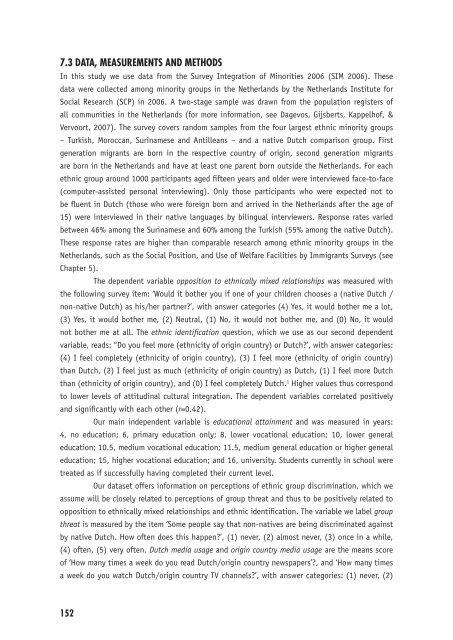Ethnic Hostility among Ethnic Majority and Minority Groups
Ethnic Hostility among Ethnic Majority and Minority Groups
Ethnic Hostility among Ethnic Majority and Minority Groups
Create successful ePaper yourself
Turn your PDF publications into a flip-book with our unique Google optimized e-Paper software.
7.3 DATA, MEASUREMENTS AND METHODS<br />
In this study we use data from the Survey Integration of Minorities 2006 (SIM 2006). These<br />
data were collected <strong>among</strong> minority groups in the Netherl<strong>and</strong>s by the Netherl<strong>and</strong>s Institute for<br />
Social Research (SCP) in 2006. A two-stage sample was drawn from the population registers of<br />
all communities in the Netherl<strong>and</strong>s (for more information, see Dagevos, Gijsberts, Kappelhof, &<br />
Vervoort, 2007). The survey covers r<strong>and</strong>om samples from the four largest ethnic minority groups<br />
– Turkish, Moroccan, Surinamese <strong>and</strong> Antilleans – <strong>and</strong> a native Dutch comparison group. First<br />
generation migrants are born in the respective country of origin, second generation migrants<br />
are born in the Netherl<strong>and</strong>s <strong>and</strong> have at least one parent born outside the Netherl<strong>and</strong>s. For each<br />
ethnic group around 1000 participants aged fi fteen years <strong>and</strong> older were interviewed face-to-face<br />
(computer-assisted personal interviewing). Only those participants who were expected not to<br />
be fl uent in Dutch (those who were foreign born <strong>and</strong> arrived in the Netherl<strong>and</strong>s after the age of<br />
15) were interviewed in their native languages by bilingual interviewers. Response rates varied<br />
between 46% <strong>among</strong> the Surinamese <strong>and</strong> 60% <strong>among</strong> the Turkish (55% <strong>among</strong> the native Dutch).<br />
These response rates are higher than comparable research <strong>among</strong> ethnic minority groups in the<br />
Netherl<strong>and</strong>s, such as the Social Position, <strong>and</strong> Use of Welfare Facilities by Immigrants Surveys (see<br />
Chapter 5).<br />
The dependent variable opposition to ethnically mixed relationships was measured with<br />
the following survey item: ‘Would it bother you if one of your children chooses a (native Dutch /<br />
non-native Dutch) as his/her partner?’, with answer categories (4) Yes, it would bother me a lot,<br />
(3) Yes, it would bother me, (2) Neutral, (1) No, it would not bother me, <strong>and</strong> (0) No, it would<br />
not bother me at all. The ethnic identifi cation question, which we use as our second dependent<br />
variable, reads: “Do you feel more (ethnicity of origin country) or Dutch?’, with answer categories:<br />
(4) I feel completely (ethnicity of origin country), (3) I feel more (ethnicity of origin country)<br />
than Dutch, (2) I feel just as much (ethnicity of origin country) as Dutch, (1) I feel more Dutch<br />
than (ethnicity of origin country), <strong>and</strong> (0) I feel completely Dutch. 1 Higher values thus correspond<br />
to lower levels of attitudinal cultural integration. The dependent variables correlated positively<br />
<strong>and</strong> signifi cantly with each other (r=0.42).<br />
Our main independent variable is educational attainment <strong>and</strong> was measured in years:<br />
4, no education; 6, primary education only; 8, lower vocational education; 10, lower general<br />
education; 10.5, medium vocational education; 11.5, medium general education or higher general<br />
education; 15, higher vocational education; <strong>and</strong> 16, university. Students currently in school were<br />
treated as if successfully having completed their current level.<br />
Our dataset offers information on perceptions of ethnic group discrimination, which we<br />
assume will be closely related to perceptions of group threat <strong>and</strong> thus to be positively related to<br />
opposition to ethnically mixed relationships <strong>and</strong> ethnic identifi cation. The variable we label group<br />
threat is measured by the item ‘Some people say that non-natives are being discriminated against<br />
by native Dutch. How often does this happen?’, (1) never, (2) almost never, (3) once in a while,<br />
(4) often, (5) very often. Dutch media usage <strong>and</strong> origin country media usage are the means score<br />
of ‘How many times a week do you read Dutch/origin country newspapers’?, <strong>and</strong> ‘How many times<br />
a week do you watch Dutch/origin country TV channels?’, with answer categories: (1) never, (2)<br />
152












